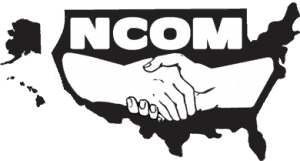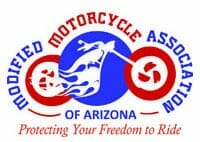
NCOM BIKER NEWSBYTES
Compiled & Edited by Bill Bish,
National Coalition of Motorcyclists (NCOM)
RPM ACT REINTRODUCED IN THE U.S. SENATE
The “Recognizing the Protection of Motorsports (RPM) Act”, S. 2602, was reintroduced in the 116th Congress on October 18, 2019 by Senators Richard Burr (R-NC) and Joe Manchin (D-WV) along with 24 original cosponsors. The bipartisan bill clarifies that it is legal under federal law to modify the emissions system of a motor vehicle that is converted for race-use-only, and protects Americans’ right to convert street cars and motorcycles for motorsports competition.
“The RPM Act confirms that transforming motor vehicles into race cars used exclusively for competition does not violate the Clean Air Act,” according to the Specialty Equipment Manufacturers Association (SEMA), adding; “This American tradition was unquestioned for nearly 50 years until 2015 when the EPA took the position that converted street vehicles that compete on the track must remain emissions-compliant, even though they are not driven on public streets or highways.”
The EPA also maintains that the equipment used to transform a street vehicle into a race car is prohibited and is to be addressed in the bill.
“American racing runs on traditions,” said Senator Burr. “For more than 50 years, motorsports enthusiasts have purchased cars and modified them to race, off of public roads. However, this tradition was threatened when the Obama EPA attempted to make these modifications illegal. This legislation upholds Congress’ intent of the Clean Air Act and protects motorsports, for professionals and amateurs alike, for years to come.”
Motorsports competition involves tens of thousands of participants and vehicle owners each year, both amateur and professional. Retail sales of racing products make up a nearly $2 billion market annually. A majority of the estimated 1,300 race tracks operating across the U.S., including oval, road, dirt and off-road tracks, feature converted race vehicles that the EPA now considers to be illegal.
TARIFFS ON EUROPEAN MOTORCYCLES AVOIDED
This past summer, representatives from KTM, Indian Motorcycle and the Motorcycle Industry Council (MIC) testified before the Office of the United States Trade Representative (USTR) in Washington, D.C. to oppose the proposed tariffs of up to 100% on motorcycles, parts and accessories arriving from European Union countries. This would have had a devastating effect on motorcycle manufacturers – especially the OEMs from Italy (Ducati, Aprilia, Moto Guzzi), Austria (KTM), Germany (BMW) and the United Kingdom (Triumph), among others.
Fortunately for the motorcycle industry, on a global scale, these proposed tariffs have been averted, according to the MIC. “Had the tariffs been enacted, that would have meant extremely high prices for our American consumers of European motorcycles, parts, and accessories,” said Erik Pritchard, incoming MIC president and CEO. “Increased costs would have even discouraged motorcycle riders from performing routine but critical maintenance, such as brake pad and tire replacements, due to potential doubling on the price of parts.”
FEDERAL LEGISLATION WOULD LIMIT ETHANOL BLENDING IN U.S. FUEL SUPPLY
A bipartisan bill has been introduced in Congress that aims to prevent Renewable Fuel Standard (RFS) blending obligations from requiring ethanol to make up more than 9.7% of the total volume of gasoline projected to be sold or introduced into commerce in the U.S. for a given calendar year.
Introduced by U.S. Representatives Bill Flores (R-TX) and Peter Welch (D-VT) on May 7, H.R. 2540, titled the “Food and Fuel Consumer Protection Act of 2019,” would cap the ethanol mandate and stop the federal government from forcing E15 fuel into the market and ensure continued availability of E10 and ethanol-free gasoline (E0), which is safer to use in motorcycles and smaller-engined vehicles and gas powered equipment.
House Resolution 2540 has been referred to the House Committee on Energy and Commerce.
“GREEN ICE INITIATIVE” IN ILLINOIS PROMOTES GRASS-FREE STREETS
ABATE of Illinois and Sangamon County Sheriff Jack Campbell have joined together on the “Green Ice Initiative” to keep the streets safer by spreading the word about the dangers of grass clippings on roadways. Dumping grass clippings on the road, they said, not only clogs storm sewers, it presents real dangers to motorcyclists and bicyclists. It is also illegal.
Josh Witkowski, the state legislative coordinator for A.B.A.T.E. of Illinois, told KPVI Channel 6 News in Pocatello, IL that the problem is often worse in rural areas, where grass can reach 2 or 3 feet before someone cuts it. The clippings then blow onto the roadway, sometimes 2 inches deep, where it can remain a hazard to riders for days.
Witkowski said he was aware of at least two fatalities, one in Kentucky and one in Illinois, where grass on the road was a factor.
As with so many other safety issues, Witkowski said it will take both education and law enforcement to create change. Dumping is a violation of the state’s litter law.
FEDERAL DATA SHOWS “OUTDOOR RECREATION” IS POWERFUL ECONOMIC DRIVER
Motorcycling, ATV riding, and side-by-side driving are among the country’s three largest outdoor recreational activities, when ranked by economic output, says a new federal report.
According to newly-released data from the U.S. Bureau of Economic Analysis (BEA), the top three conventional outdoor activities generated $9.1 billion in economic output in 2017. Outdoor recreation accounts for 2.2% of U.S. GDP, creating $778 billion in gross output supporting 5.2 million jobs.
And, it’s a growth sector.
According to the BEA release, its Outdoor Recreation Satellite Account “shows that inflation-adjusted (real) GDP for the outdoor recreation economy grew by 3.9% in 2017, outpacing the 2.4% growth of the overall U.S. economy. Outdoor recreation is responsible for a larger share of GDP than many major industries, including chemical products manufacturing, farming and ranching, mining, and utilities.
The bureau defines “conventional” outdoor recreation as activities done for pleasure, such as camping, hiking, hunting, and fishing, and involving some physical effort.
The economic data on the national and, for the first time ever, state levels reinforce what the outdoor recreation industry has long believed: Outdoor recreation is a powerful driver of national and local economies and it is growing faster than the U.S. economy as a whole.
This is the second consecutive year that the Bureau of Economic Analysis (BEA), an agency of the U.S. Department of Commerce, has released formal, national-level data, a notable milestone for the industry now identified as a unique sector of the economy. “Having a rich set of both state and national data on outdoor recreation to draw upon will inform decision-making by businesses, policymakers, and managers of public lands and waters,” notes the Motorcycle Industry Council (MIC).
MOTORISTS URGED TO “SEE BIKE SAY BIKE”
The University of Nottingham in England has found that when car drivers audibly say the word “bike” when seeing one at an intersection could drastically reduce the chances of an accident.
One of the most common types of accidents for motorcyclists is a driver pulling out in front of them, traditionally referred to in the U.S. as “R-O-W”, or left-turn Right of Way violation. Previously, such incidents have been interpreted as failures to see the bikes, but a professor at the University of Nottingham thinks it has more to do with forgetting they were there at all.
Dr Peter Chapman has conducted research that he claims proves that car drivers see the bike on the road but that their brain ‘forgets’ it is there at all.
The study found that drivers were five times more likely to fail to act to an oncoming motorcycle than you would be if a car was positioned in the same place and at the same speed. Dr Chapman and his team have not completely got to the bottom of why a car driver does this, but they think the car driver’s brain becomes distracted between the time they see the bike and when they decide to pull out.
The theory is that speaking the word “bike” aloud when you see one approaching at a junction could help to strengthen the memory of seeing the motorcycle, helping to prevent the brain from overwriting it with what the driver wants for lunch or how late they are for that meeting.
It is hoped that drivers resorting to such nursery-rhyme type of memory games can help them become safer drivers – possibly avoiding the necessity of enacting harsher penalties for dangerous and careless driving.
AUSTRALIAN AUTHORITIES DEPLOY A.I. CAMERAS TO DETECT TEXTING DRIVERS
If you feel somebody’s watching you, it may not be paranoia. While modern mobile devices are the ultimate tools of convenience, when in the hands of drivers these handheld computers also contribute to increased accidents and fatalities on our roadways — particularly for motorcyclists who are more vulnerable. To help curb distracted behavior behind the wheel, Australia has deployed surveillance devices that peek inside the passenger compartment and sanction those driving under the influence of smartphones.
During the pilot phase of the Mobile Phone Detection Camera (MPDC) initiative, 8.5 million vehicles were checked from January 2019 to June 2019 in the Australian state of New South Wales. Though citations weren’t administered during the test period, 100,000 drivers were caught handling devices while operating their vehicles.
Once the pilot phase ends, violators will receive a $344 AUD fine (about $230 USD) and a 5 point penalty on their driving record. Drivers also have little clemency with the system as the MPDC can be fixed or mobile, works day and night, and operates in all weather conditions.
By the end of 2019, Australia will deploy 45 MPDCs with plans to expand the program through 2023.
HARLEY-DAVIDSON TO LAUNCH GROUP-GUIDED CRUISE CONTROL
Harley-Davidson has applied for a patent that will enable groups of riders to maintain a constant speed thanks to kinematics and radar-guided cruise control. This new type of adaptive cruise control is specifically aimed at Harley’s current target demographic; groups of riders.
Adaptive cruise control is nothing new in the world of four-wheeled transportation, but now a major motorcycle manufacturer has stepped in with a system that is claimed to allow a bike to lock on to another bike and keep a set separation distance or separation time from the target bike while offering the rider the chance to pick multiple bikes or cars within a lane to follow.
The Harley system incorporates a transceiver that can ping out the bike’s location to other vehicles on the road, so with a group of riders sharing the same piece of tarmac, and using the same H-D adaptive cruise control system, a group of bikes can track and monitor the location of each other in real-time for a safer and more controlled group riding experience.
WORLD RECORD HARLEY GATHERING
Paris Harley-Davidson, a dealership located in Paris, Texas, recently set a new Guinness World Record for the “Most Harley-Davidson Motorcycles in a Parade”.
The number to beat was 2,404, which was held by the Hellas Motorcycle Club in Greece since 2010, and on Oct. 5, 2019 the Paris H-D parade crushed that mark with 3,497 motorcycles. Harley enthusiasts from 48 states, Canada and Europe traveled to the event to take part in the historic gathering.
”WE DID IT! We brought it home to AMERICA,” posted motorcycling philanthropist Adam Sandoval, a participant known for riding to every Harley-Davidson dealership in the lower 48 states with his dog Scooter to raise money and awareness for our military and their families.
Paris H-D was quick to give props to local law enforcement and first responders, along with countless volunteers and supporters.
QUOTABLE QUOTE: “If they can get you asking the wrong questions, they don’t have to worry about the answers.”
~ Thomas Pynchon (b. 1937), American novelist
ABOUT AIM / NCOM: The National Coalition of Motorcyclists (NCOM) is a nationwide motorcyclists rights organization serving over 2,000 NCOM Member Groups throughout the United States, with all services fully-funded through Aid to Injured Motorcyclist (AIM) Attorneys available in each state who donate a portion of their legal fees from motorcycle accidents back into the NCOM Network of Biker Services (www.ON-A-BIKE.com / 800-ON-A-BIKE).
